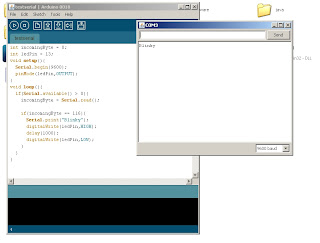


You can also change the baud rate in line 3 of the Python program and line 2 of the Arduino program as long as they stay the same. Often I find myself outputting to the serial monitor, copy-pasting data into excel, formatting, doing calculations. Whatever that is should be what is in quotes in line 3 of the Python program. Has lead me to explore the options of getting Arduino serial output into Python.
#PYTHON READ SERIAL DATA FROM ARDUINO CODE#
Here is the code (I omitted most part of the code, but the loop is the same): ser = serial.Serial('/dev/ttyUSB0', 2000000, timeout=2, xonxoff=False, rtscts=False, dsrdtr=False) #Tried with and without the last 3 parameters, and also at 1Mbps, same happens. To determine what serial port your Arduino is connected to look at the bottom right corner of your Arduino sketch.
When opening the serial port via pySerial I see all messages but instead of receiving 100-150x per second i receive them at about 5 per second (still the message increments 1 by 1) but they are probably stored in some buffer as when I power off the PIC, i can go to the kitchen and come back and im still receiving messages. In addition, I have limited the scope of this post to just sending float and int data types since these 2 data types will be sufficient. This method also allows the user to bridge the gap between live data and laboratory measurements. When opening the serial port via Putty I see all messages (the counter in the message increments 1 by 1). In this section, we will focus on sending data from the Arduino to the computer over a serial connection, and then plotting it with Python.We will use the data from a potentiometer as an example for the code below since it involves only a simple analogRead(). Printing data to Arduino's serial port and then reading it through Python gives the user the freedom to investigate the data further, and take advantage of the advanced processing tools of a computer, rather than a micro controller. They boil down to: Interpreting the data received from the Arduino is done in the Arduino class, which will make it harder to reuse the code it the future, and makes the code harder to quickly read and understand. The third step is to create a new Python file and import the serial module and the csv module. I wouldn't call it bloated, but there are a few structural problems related to the Arduino class. Develop Python Code to Read Serial Data from Arduino. On my laptop I have Xubuntu running as virtual machine, I can read the serial port via Putty and via my script (python 2.7 and pySerial) Now, it’s time to move into Python and develop the code that can read and log data from our serial connection. Im sending messages (size of about 15 chars) about 100-150x times a second and the number there increments (to check if i have messages being lost and so on) The PIC works with perfect timing at 2Mbps, also the FTDI usb-serial port works great at 2Mbps (both verified with oscilloscope) Return json.I am using a script in Python to collect data from a PIC microcontroller via serial port at 2Mbps. On the Python side, I have a basic Flask app with a /distance route that returns a JSON object with the serial value: from flask import Flask import csv import serial Open com port ser serial.Serial ('COM4', 115200) with open ('datafile.csv', 'w') as newfile: csvwriter csv.writer (new. 
import serial import json serial serial.Serial ('/dev/ttyUSB0', 9600, timeout1) while True: data serial.readline ().strip (' \r') j json.loads (data) print (data) print j 'temp' No matter what I try to. For this reason, we choose arbitrarily to stop reading after 10 lines. I am trying to use the following python script to read from the serial port and print out the various values of the json string. When monitoring the serial data, the output looks similar to: 5.13.15.12.123.39.345. In this case, since all the lines end with E, we don't have any way to know when to stop processing the lines. Integer is a 32-bit type while your serial port would be set. That is the not the right way to read an Integer from Arduino. serserial.Serial ('com3',9600,timeout 1) ser.write (b'S') Xser.read (1) print (X) And write the integer from the arduino once you get this start bit. In the case of Raspberry Pi, the serial port (on my Arduino) is located at /dev/ttyACM0. So write a character from pyserial to arduino to signal start like. In the first part of the article, I’ll describe how you can write an Arduino program that captures data from its sensors in the second part, I’ll describe how you can write a Python script that reads the Arduino’s data and writes it to a CSV file. Using the MaxSonar playground code, I have Arduino writing the number of inches to serial every. These three simple lines read a single row of data from the serial port. That char 's' is sent by python based on an image read from screen. I'm working on a little project using the MaxSonar EZ1 ultrasonic range sensor and Arduino Diecimila. Im trying to make Arduino trigger a relay if the char 's' is read on serial port.







 0 kommentar(er)
0 kommentar(er)
